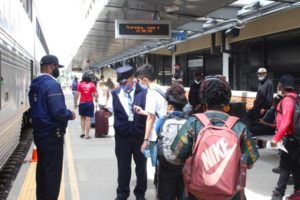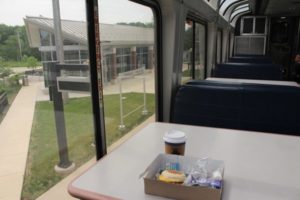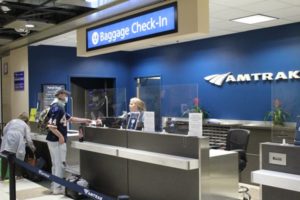NORMAL, Ill. — “It’s definitely getting better,” Amtrak conductor Keith Inglesby says, considering ridership during a recent trip aboard the Texas Eagle.

Of course, Trains News Wire’s round trip to Normal aboard the Eagle could only offer anecdotal hints about how soon passengers might be returning to Amtrak after bottoming out in April [see “Coronavirus contraction,” “Passenger,” July 2020 Trains].
But the journey did provide a relatively encouraging snapshot of what it’s like to ride today. The Sightseer lounge and coaches — including the bathrooms — were spotless in both directions. Everyone is now required to wear a cloth mask during the boarding process, but patrons on both trains seemed to take the order in stride. About half of the passengers took off their masks while seated; most wore them while walking through the train.

So-called “flexible dining” for sleeping car passengers was in effect, meaning the Superliner lounge’s lower-level cafe fare was the only food option for coach passengers. All of the fresh deli sandwiches were listed as “sold out,” so breakfast sandwiches, hot dogs, burgers, and individual pizza were the only non-snack choices. All the cheeseburgers were gone for the train’s last northbound lunch.
Few people stayed in the big-windowed lounge after making a purchase, but a woman traveling with her young daughter from New York to Dallas took advantage of the spaciousness. Seating was allowed only at every other table, yet two couples in their 20s traveling together were the car’s only occupants for most of the northbound trip.
Sell-out dilemma
Will reduced overnight train capacity limits unnecessarily stunt ridership growth? Amtrak spokesman Marc Magliari tells News Wire that there have been “no significant changes” in train consists from the April and early May period. Because every long-distance train except the Sunset Limited and Auto Train augments at least a portion of a state-supported corridor, however, there have recently been more than a few sell-outs across the system.

On June 4, for example, the Texas Eagle had one seat available the next day from Chicago to Dallas at a whopping $260. The coach fare from Pontiac, Ill., was $251 but from Normal it was only $124. Yield-management pricing, coupled with reduced capacity, dictated the high fare on the segment where the load was heaviest, but by the following day — no surprise — the seat was gone. News Wire spot checks also recorded Eagle sell-outs from Normal to Chicago on May 26 and Chicago to Springfield, Ill., on May 31.
Elsewhere, the southbound Silver Meteor had no coach seats available out of Washington to Orlando on June 5 and 6, while the southbound Crescent coaches were sold out south of Charlottesville, Va., on June 5. Also on that day, both the Empire Builder to St. Paul (operating with three Superliner coaches) and Capitol Limited to Pittsburgh (two coaches) were showing one seat available out of Chicago.
During 15 days of News Wire monitoring ending May 31, the westbound Lake Shore Limited had no day-of-departure seats on 11 of 15 days out of New York when that train was running with one Amfleet II coach. Since then, the consist was spotted pulling through the washer in Chicago with four coaches, presumably two from Boston and two from New York. Even then, only one seat was available June 5 from New York to Chicago, at twice the normal $112 rate; space opened up after Cleveland.
Meanwhile, Amtrak sources tell News Wire that the company ran a special train of 15 empty Amfleet II coaches from its Hialeah Maintenance Facility near Miami to Jacksonville, Fla., for storage on May 29. The move may save short-term maintenance costs, but handicap Amtrak’s ability to quickly expand capacity to meet demand on its eastern long-distance trains, which all provide service along corridors where state-sponsored frequencies have been reduced.
Spot checks of all overnight routes have revealed very few sleeping car sell-outs or increased pricing from what Amtrak usually charges during the summer months, but capacity per car has not been limited because the rooms offer isolation that coach seats or air travel do not. The private accommodations’ attractiveness could provide a marketing opportunity to expand revenue per passenger if Amtrak management had the inclination to promote sleeping cars as a unique option once travel begins to ramp up.
The round trip to Normal shows that process may be well underway.













